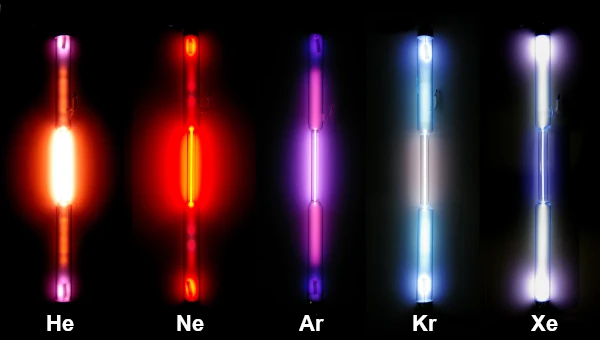
Image description: Illustration of certain noble gases—helium, neon, argon, krypton, and xenon—inside a low-pressure glass tube. When an electric voltage is applied, the gas electrons are excited to higher energy levels. As they return to their lower energy state, they emit light. Helium emits orange-red light, neon emits red, argon violet, krypton pale green, and xenon blue-white. Radon is not used in discharge tubes due to its radioactivity.
Noble gases, also known as rare or inert gases, form a group of chemical elements located in the last column of the periodic table. This group includes helium (He), neon (Ne), argon (Ar), krypton (Kr), and xenon (Xe).
Their rarity is marked by their extremely low chemical reactivity. This unique characteristic results from their stable electronic configuration, which means they have complete outer electron shells. This makes them resistant to forming chemical compounds, unlike other, often more reactive gases.
Due to this stability, noble gases are usually found as monatomic molecules (comprising single atoms). They rarely react with other elements and are "rare" because they are seldom involved in chemical reactions.
Note: Radon is a noble gas but is not part of the so-called "inert" or "noble" gases due to its radioactivity, which poses significant health concerns.
Noble gases are characterized by an atomic structure that grants them exceptional chemical stability. This structure is defined by an electron configuration in which the outer electron shell (or valence shell) is complete, making these elements very unreactive.
Although these gases are rare in Earth's atmosphere, with relatively low concentrations, they are of significant industrial and scientific importance.
Noble gases are fascinating elements that combine unique properties of chemical stability and rarity in Earth's atmosphere. Although rare in concentration, their exceptional characteristics make them indispensable resources for a variety of modern technologies.